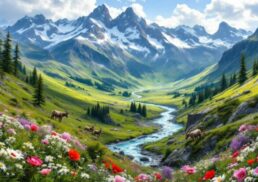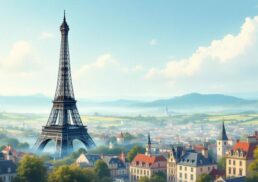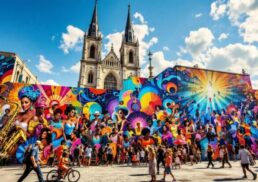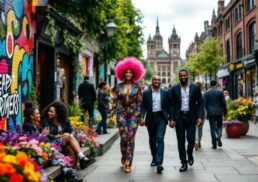The UAE, or United Arab Emirates, is a federation in the Arabian Peninsula known for its rapid development and economic growth. Learn about its history, politics, economy, major cities, demographics, foreign relations, infrastructure, culture, military, tourism, and sustainability in this comprehensive profile.
Table of Contents
Key Takeaways
The United Arab Emirates has a rich historical background, with human settlement tracing back to diverse ancient periods such as the Neolithic and Paleolithic Ages, along with significant cultural periods like the Hafit, Umm Al Nar, and Wadi Suq cultures.
The UAE’s political structure is a federal presidential elective constitutional monarchy, where the Federal Supreme Council, composed of the rulers of the seven emirates, elects the President and Vice President every five years, ensuring both unity and significant autonomy for each emirate.
Economic diversification has been crucial for the UAE, with significant investments in non-oil sectors such as tourism, finance, and technology, contributing to a 3.1% economic growth in 2023, while the oil and gas sector still plays a vital role, accounting for 26% of GDP and aiming for increased production capacities by 2027.
Historical Background
The history of the United Arab Emirates is a rich mosaic that stretches back to ancient times. Evidence of human settlement in the region dates back to 125,000 years ago, with archaeological finds at Jebel Faya in Sharjah revealing remnants from the:
Neolithic Age
Paleolithic Age
Stone Age
Bronze Age
These early settlers left behind a wealth of artifacts, including pottery, jewelry, weapons, and human and animal remains, showcasing the region’s long-standing history of human habitation.
Several distinct cultural periods mark the UAE’s ancient history. These include:
The Hafit period (3200-2600 BCE), renowned for its beehive-shaped tombs and Jemdet Nasr pottery.
The Umm Al Nar culture (2600-2000 BCE), known for its advanced metallurgical skills and trade connections.
The Wadi Suq culture (2000-1300 BCE), which continued the legacy of innovation and trade.
The Iron Age in the UAE, spanning from 1200 to 300 BCE, is divided into three periods, each reflecting the region’s evolving social and technological advancements.
The UAE’s history is also marked by its strategic trading locations, such as:
The Al Ain/Buraimi Oasis, which served as a vital post for camel routes between the coast and the Arabian interior
The Hellenistic Mleiha era around 300 BCE
The early Christian sites discovered in the 1990s on Sir Bani Yas Island
These historical layers provide a fascinating glimpse into the UAE’s rich and diverse past.
Formation of the United Arab Emirates
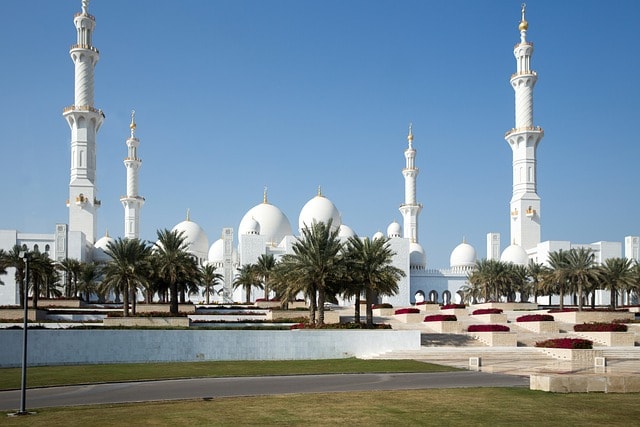
The establishment of the United Arab Emirates marked a significant turning point in the region’s history. The journey began in 1968 when the British government announced its decision to end the treaty relationships with the seven trucial sheikhdoms. This announcement set the stage for a new era, as Sheikh Zayed bin Sultan Al Nahyan, the Ruler of Abu Dhabi, and Sheikh Rashid bin Saeed Al Maktoum, the Ruler of Dubai, called for a federation that would include the seven Emirates, Qatar, and Bahrain.
On December 2, 1971, the federation known as the United Arab Emirates was officially established by six of the Emirates, with Ras Al Khaimah joining the following year. Annually, the UAE commemorates this day as National Day, celebrating its journey from inception to becoming a significant force on the global platform. The UAE’s formation was a testament to the vision and leadership of its founding fathers, who navigated the complexities of unification to create a stable and prosperous country.
Political Structure and Governance
The UAE’s political system seamlessly merges traditional leadership with contemporary governance, functioning as a federal presidential elective constitutional monarchy. At the heart of this system is the Federal Supreme Council, composed of the rulers of the seven emirates. This council holds the authority to elect the President and Vice President every five years, a role typically held by the ruler of Abu Dhabi and the ruler of Dubai, respectively.
The President and Prime Minister lead the UAE, with the latter heading the Council of Ministers, or Cabinet, which consists of 22 members. The Federal National Council (FNC), a 40-member advisory body, plays a crucial legislative and supervisory role, with its members partly appointed and partly elected. This structure ensures a balance of power, with federal powers overseeing foreign affairs, security, defense, and national education.
Each emirate retains significant autonomy, managing its internal affairs and resources independently. Decisions in the Federal Supreme Council are made by a majority vote, but substantive issues require a two-thirds majority, including the agreement of Abu Dhabi and Dubai. This system of governance allows for both unity and diversity, enabling the UAE to maintain stability while fostering growth and development across its emirates.
Economy and Economic Diversification
Despite global economic obstacles, the UAE flaunts a strong and diverse economy, demonstrating remarkable growth and resilience. The nominal gross domestic product (GDP) stands at US$414.2 billion, showcasing the strength of the UAE’s economy. Over the years, the UAE has focused on economic diversification to reduce its dependence on oil, investing heavily in sectors such as tourism, finance, and technology.
Economic diversification has been a cornerstone of the UAE’s strategy in the 21st century, resulting in significant growth in non-oil sectors. In 2023, the economy grew by 3.1%, driven by dynamic non-oil sectors and a slight drop in hydrocarbon GDP. This diversification is evident as non-hydrocarbon revenue now makes up approximately 45% of the government’s total revenue. The UAE’s business environment ranks highly globally, reflecting its competitive advantage and strategic planning.
Oil and Gas Sector
As a fundamental pillar of the UAE’s economy, the oil and gas sector contributes 26% to its GDP and is responsible for approximately 40% of the country’s export revenue. The journey of oil exploration in the UAE began in the early 1930s, with the first cargo of crude oil exported from Abu Dhabi in 1962. This sector has since evolved, with the UAE aiming to increase its oil production capacity to 5 million barrels per day by 2027.
In addition to oil, the UAE is focusing on becoming a net gas exporter by 2030, enhancing its role in the global energy market. The country’s strategic location in the Persian Gulf region and ongoing onshore exploration efforts underscore its commitment to maintaining a leading position in the oil and gas sector. Despite the global push towards renewable energy, the oil and gas sector continues to play a vital role in the UAE’s economic landscape.
Non-Oil Sectors
The UAE’s push towards economic diversification has produced notable outcomes, especially in the non-oil sectors. Between 1981 and 2012, the UAE’s non-oil trade increased by approximately 28 times, illustrating the success of these diversification efforts. Sectors such as tourism, finance, and technology have experienced substantial growth, contributing to the nation’s economic resilience.
This diversification has not only bolstered the economy but also promised a more versatile and sustainable future for the UAE. The significant investments and strategic planning in these sectors have positioned the UAE as a global leader in innovation and economic development. As the country continues to reduce its reliance on the oil and gas sector, the non-oil sectors are expected to play an increasingly important role in driving economic growth and stability.
Major Cities and Urban Development
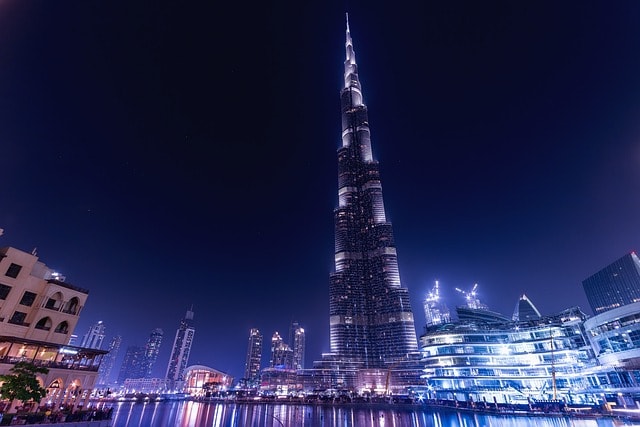
Major cities in the UAE include:
Dubai
Abu Dhabi
Sharjah
Al Ain
Ajman
Each city has its unique characteristics and development projects that contribute to the nation’s diverse urban fabric. Dubai, the most populous city, is renowned for its rapid growth and iconic landmarks. Meanwhile, Abu Dhabi, the capital city, is a hub of political and cultural significance.
Other emirates in the UAE include:
Sharjah, known for its cultural heritage
Al Ain, the ‘Garden City’ due to its greenery and parks
Ajman
Ras Al Khaimah
Fujairah
Umm Al Quwain
Each of these cities has its unique attributes, further enriching the UAE’s urban landscape. They not only showcase the UAE’s development but also its commitment to preserving cultural heritage while embracing modernization.
Abu Dhabi
As the UAE’s capital city, Abu Dhabi epitomizes the nation’s cultural and political identity. The city is home to several iconic landmarks, including the Sheikh Zayed Grand Mosque, one of the largest mosques in the world, which stands as a testament to the UAE’s rich Islamic heritage. The Louvre Abu Dhabi, located on Saadiyat Island, is another cultural gem, showcasing a blend of art and history from around the world.
Other notable landmarks in Abu Dhabi include the Observation Deck at 300, offering panoramic views from the 74th floor of the Etihad Towers, and Qasr Al Hosn, one of the oldest and most historically significant buildings in the city. These sites not only attract tourists but also reflect the city’s dedication to preserving its heritage while fostering modernity.
As the capital city, Abu Dhabi plays a crucial role in the UAE’s national identity and development.
Dubai
As the UAE’s most populous city, Dubai globally symbolizes swift growth and innovation. The city’s economy grew by 3.5% in 2023, driven by the logistics, transport, and retail sectors. Dubai’s skyline is dotted with iconic structures such as the Burj Khalifa, the world’s tallest building, and the Burj Al Arab, a symbol of luxury and architectural excellence.
Dubai’s artificial archipelago, Palm Jumeirah, and the expansive Dubai Marina, one of the largest man-made marinas in the world, are testaments to the city’s ambitious development projects. As an international hub, Dubai continues to attract millions of visitors and investors, contributing significantly to the UAE’s economy.
The city’s blend of modernity and tradition makes it a unique and dynamic urban center.
Other Emirates
Apart from Abu Dhabi and Dubai, every other emirate in the UAE adds to the nation’s diversity and development. Sharjah, for instance, is renowned for its rich cultural heritage and numerous museums, earning it the title of the cultural capital of the UAE. The emirate’s dedication to arts and culture is evident in its many cultural institutions and events.
Ras Al Khaimah, Fujairah, Umm Al Quwain, and Ajman each have their unique characteristics that enrich the UAE’s landscape. Ras Al Khaimah is known for its natural beauty and outdoor activities, while Fujairah boasts a scenic coastline along the Gulf of Oman. Umm Al Quwain and Ajman, though smaller, contribute to the UAE’s rich tapestry with their distinct local cultures and attractions.
Together, these emirates showcase the UAE’s commitment to balancing modernization with cultural preservation.
Demographics and Society
With an estimated UAE population of around 10 million in 2024, the country exhibits rapid growth and a cosmopolitan character. The demographic landscape is dominated by expatriates, who make up approximately 88.52% of the population. This diverse mix of people from different ethnic backgrounds contributes to the vibrant and multicultural society that the UAE is known for.
Urbanization is a significant feature of the UAE, with 94% of the population living in urban areas as of 2023. Major cities like Dubai and Abu Dhabi account for a substantial portion of the population, with Dubai hosting 35.6% and Abu Dhabi 31.2%. This urban concentration reflects the UAE’s development as a hub of economic and social activity.
Population Distribution
Most UAE residents live in urban centers such as Dubai, Abu Dhabi, and Sharjah, indicating a significant population concentration in these cities. This urbanization is driven by the country’s economic opportunities and modern infrastructure.
The population density stands at 114 people per square kilometer, highlighting the concentration of people in these vibrant urban areas.
Ethnic Groups and Languages
As a historical trade hub and a current hotspot for expatriates, the UAE is a cultural melting pot of various ethnic groups. The diverse demographic makeup of the UAE includes:
Emiratis, who constitute the native population
Expatriates from South Asia
Expatriates from Southeast Asia
Expatriates from the Arab world
This diverse population enriches the cultural fabric of the nation.
Arabic is the official language of the UAE, underscoring its Arab cultural heritage. However, English is widely spoken and serves as the lingua franca, especially in business and government settings. Other languages that are prevalent in the UAE include:
Hindi
Urdu
Bengali
Tagalog
These languages are spoken due to the significant expatriate communities in the country. This linguistic diversity further enhances the UAE’s cultural landscape.
Religion and Cultural Practices
Islam is the predominant religion in the UAE, shaping much of the country’s cultural and social practices. The UAE’s Islamic heritage is reflected in daily life, with Emirati men traditionally wearing the Gutra and Bisht, and women donning the Abaya. These traditional garments are a testament to the country’s respect for its cultural roots.
Cultural practices in the UAE are deeply intertwined with religious observances, such as Ramadan and Eid al-Adha. Despite the modern cosmopolitan lifestyle, traditional values of family, respect, and hospitality remain central to Emirati society. The regulation of alcohol and pork sales in major supermarkets also reflects the cultural and religious norms of the region.
Foreign Relations and International Presence
As an active global participant, the UAE maintains robust diplomatic ties and holds memberships in numerous international organizations. Its membership in the United Nations, the Gulf Cooperation Council, the Arab League, and other bodies underscores its commitment to international cooperation. The UAE’s recognition of Israel in 2020, resulting in a historic peace agreement, highlights its progressive approach to diplomacy.
The UAE’s strategic geographical position and solid economic base enhance its foreign relations. The country is a key ally of the United States, particularly in military and security matters. These diplomatic ties have strengthened the UAE’s international presence, making it a significant player in regional and global affairs.
Diplomatic Relations
The UAE’s diplomatic relations are marked by its active participation in regional and global organizations. As a member of the Gulf Cooperation Council and the Arab League, the UAE plays a pivotal role in Middle Eastern politics. The normalization of relations with Israel in 2020 through the Abraham Accords was a landmark achievement, paving the way for enhanced cooperation and peace in the region.
The UAE’s strategic alliances extend beyond the Middle East, with strong ties to Western powers like the United States. As one of the closest military partners of the US in the Middle East, the UAE provides vital support in terms of military, logistical, and intelligence cooperation. These relationships underscore the UAE’s commitment to maintaining stability and security in the region.
Foreign Workers
The UAE’s economic success is largely driven by its significant expatriate workforce, which makes up approximately 90% of the total workforce. These foreign workers are integral to the country’s development, contributing to various sectors from construction to professional services. However, the UAE faces challenges in ensuring safe and fair working conditions for these workers.
Reports of unsafe working environments, exploitation, and health risks due to extreme heat highlight the need for improved labor regulations and enforcement. Despite legal prohibitions against confiscating employees’ passports, issues of labor abuse persist, particularly among workers hired on tourist visas. Addressing these challenges is crucial for maintaining the UAE’s reputation as an attractive destination for expatriates.
Geography and Climate
Situated on the Arabian Peninsula, adjacent to the Gulf of Oman and the Persian Gulf, the UAE’s strategic location confirms its crucial role in regional trade and geopolitics. Spanning an area of 83,600 square kilometers, the UAE comprises diverse landscapes, from coastal plains to desert interiors. The country’s geographic features, including the Omani exclave of Wadi Madha, add to its strategic importance.
The climate in the UAE is subtropical-arid, with the following characteristics:
Hot summers
Warm winters
High temperatures throughout the year, with summer temperatures reaching up to 50°C
Milder winters in coastal regions, with average minimum temperatures ranging between 10 and 14°C
Occasional dust storms
High carbon dioxide emissions per capita
These unique challenges are a result of the country’s climate and environment.
Geographic Location
The UAE’s positioning on the Arabian Gulf, near the Persian Gulf coast, endows it with considerable geopolitical advantages. The country offers access to ports and territory for international forces, including the UN, US, EU, and NATO, facilitating critical logistical and military operations.
This strategic position underscores the UAE’s role as a vital transit point and a key player in regional and global trade.
Climate and Environment
The UAE’s climate is marked by extreme temperatures, particularly in the summer months when maximum temperatures can exceed 45°C on the coastal plains. The winter season brings more moderate temperatures, providing a respite from the intense heat. Rainfall is sparse, averaging between 140 to 200 mm annually, with some mountainous areas receiving up to 350 mm.
Environmental challenges such as dust storms, known locally as shamal winds, are common, affecting air quality and visibility. Additionally, the UAE ranks high in carbon dioxide emissions per capita, reflecting the environmental impact of its rapid industrialization and urbanization. Addressing these environmental issues is crucial for the UAE’s sustainable development.
Learn more, Check out Seasons in the UAE: Weather and Climate.
Infrastructure and Development
Forefronting infrastructure development, the UAE heavily invests in innovative and sustainable projects. The country’s well-connected transportation system and cutting-edge technology exemplify its commitment to modernization and economic diversification. Major infrastructure projects, including the Dubai Metro and extensive port facilities, highlight the UAE’s strategic planning and investment in its future.
Dubai, in particular, is known for its ambitious infrastructure projects, such as the planned Dubai Metro Blue Line, which will enhance the city’s public transportation network. The UAE’s major ports, including Khalifa Port and Port Jebel Ali, serve as critical hubs for international trade, reinforcing the country’s status as a global logistics center.
Transportation
The UAE’s transportation infrastructure is among the most advanced in the region. The Dubai Metro, with its Red, Green, and upcoming Blue Line, provides efficient and reliable public transit for residents and visitors alike. The Roads and Transport Authority (RTA) in Dubai is continually upgrading bus stations and depots, ensuring that the city’s transportation system meets the growing demand.
Innovative projects like self-driving electric abras and the planned launch of flying taxis reflect the UAE’s commitment to sustainability and technological advancement. By 2030, Dubai aims for 25% of all journeys to be autonomous, showcasing the city’s forward-thinking approach to transportation. The RTA’s ‘360 Services’ policy further enhances convenience by making over 90% of processes accessible online.
Telecommunications
The UAE’s telecommunications sector has seen significant advancements, particularly with the nationwide installation of 5G wireless services in 2019. This milestone marks the UAE’s commitment to staying at the forefront of technology and ensuring high-speed connectivity for its residents and businesses.
The Telecommunications Regulatory Authority also mandates content filtering for religious, political, and sexual content, reflecting the country’s regulatory approach to internet usage.
Culture and Lifestyle
Emirati culture is a unique blend of Islamic traditions and Bedouin customs, coexisting harmoniously with rapid modernization. Family, respect, and hospitality are core values in Emirati society, and these principles are evident in social customs and daily interactions. Traditional Emirati cuisine, including dishes like Harees and Machboos, is often enjoyed during celebrations, reflecting the country’s rich culinary heritage.
The UAE’s cultural scene is vibrant, with both traditional crafts like pottery and weaving and modern art forms thriving. Festivals and events play a significant role in Emirati culture, bringing communities together and celebrating the nation’s heritage. This blend of tradition and modernity creates a dynamic cultural landscape that attracts visitors and residents alike.
Traditional and Modern Influences
The UAE’s culture is deeply rooted in Islamic and Bedouin traditions, which are evident in daily life and social customs. Emirati men traditionally wear the Dishdasha or Kandura, while women wear the Abaya, reflecting the country’s respect for its cultural heritage. Traditional Emirati art, including pottery and weaving, continues to thrive alongside modern art forms, showcasing the blend of old and new.
Modern influences are also prominent in the UAE’s cultural landscape. The nation has embraced rapid modernization, with advancements in technology, infrastructure, and lifestyle. This harmonious coexistence of tradition and modernity is evident in the UAE’s festivals, culinary practices, and social values, creating a unique cultural experience for both residents and visitors.
Sports and Recreation
Sports and recreation are integral parts of life in the UAE, reflecting both traditional and modern influences. Camel racing, a sport deeply rooted in Bedouin heritage, remains popular today, with modern innovations like robot jockeys enhancing the experience. Falconry, another traditional sport, connects Emiratis to nature and respects the tradition of hunting with birds.
Modern sports also thrive in the UAE. Football is one of the most popular sports, with several prominent teams and a strong following. The UAE hosts major international sporting events, such as the Abu Dhabi Grand Prix and the Omega Dubai Desert Classic, attracting athletes and fans from around the world. These events not only boost the local economy but also showcase the UAE’s commitment to promoting sports and recreation.
Military and Defense
The UAE’s military capabilities are among the most advanced in the Arab world, earning it the nickname ‘Little Sparta’ from US defense officials. In 2022, the UAE allocated US$20.4 billion to defense, representing 4% of its GDP. The UAE military has been involved in several international conflicts, including operations in:
Somalia
Kosovo
Kuwait
Afghanistan
Libya
Syria
Yemen
The UAE’s strategic investments in human capital, modernization, and technology have significantly enhanced its military capabilities. The introduction of universal conscription for men between 18 and 30 years old in 2014 further bolstered the armed forces. These efforts have positioned the UAE as a formidable military power in the region, capable of addressing various security challenges.
UAE Armed Forces
The UAE armed forces, comprising around 63,000 active uniformed personnel, are known for their strategic planning and modernization efforts. The military has made significant investments in advanced equipment, such as the upgraded Rafale F4 fighter jets, enhancing its airpower capabilities. The UAE military’s involvement in countering regional threats and participating in international interventions underscores its strategic importance.
Universal conscription introduced in 2014 has strengthened the UAE’s military readiness, ensuring a steady supply of trained personnel. The presence of foreign auxiliary and mercenary forces further augments the UAE’s defense capabilities. These developments reflect the UAE’s commitment to maintaining a robust and capable military force.
Defense Agreements
The UAE’s defense strategy is bolstered by key international partnerships, particularly with the United States and France. The bilateral Defense Cooperation Agreement signed with the US in 2019 highlights the close military ties between the two countries. The UAE provides critical support in the war on terror, offering military, logistical, and intelligence assistance.
In addition to its partnership with the US, the UAE has strong defense ties with France. The defense agreements between the two countries include:
The purchase of 80 upgraded Rafale fighters
The purchase of 12 Airbus-built combat helicopters
France maintaining a naval base in the UAE
France stationing military personnel in the UAE
These defense agreements underscore the depth of the relationship between the UAE and France and are crucial for the UAE’s strategic and operational capabilities.
Tourism and Attractions
Tourism significantly contributes to the UAE’s economy, with the following key statistics:
International visitor expenditure surpassed AED 175 billion in 2023.
The travel and tourism sector’s GDP contribution is expected to reach AED 280.6 billion by 2028.
Tourism-related jobs have seen substantial growth, underscoring the sector’s importance to the UAE’s economy.
The UAE’s diverse attractions, from modern architectural marvels to cultural heritage sites, draw millions of visitors each year. Dubai, Abu Dhabi, and Sharjah are major tourism hubs, each offering unique experiences that cater to a wide range of interests. The country’s strategic focus on tourism continues to drive economic growth and global recognition.
Key Tourist Destinations
Dubai’s array of iconic landmarks makes it a top tourist destination. Visitors can explore:
The Dubai Mall
The Dubai Museum
The Al Fahidi Historical District
The Burj Khalifa
The Burj Al Arab
These are must-see landmarks that epitomize Dubai’s architectural prowess and luxury.
Other emirates also offer significant tourist attractions. Some examples include:
Al Ain, known for its historical sites like Al Jahili Fort and Jebel Hafeet mountain, provides a glimpse into the UAE’s rich heritage.
Sharjah’s museums offer a cultural experience.
Ras Al Khaimah’s natural beauty is a must-see.
Fujairah’s scenic coastline along the Gulf of Oman is perfect for beach lovers.
These attractions add to the UAE’s diverse tourism landscape.
Events and Festivals
The UAE hosts a vibrant calendar of annual events and festivals that attract visitors from around the globe. The Dubai Shopping Festival, initiated in 1996, is one of the most popular events, known for its discounts, concerts, and fireworks. The Abu Dhabi Grand Prix, a prestigious Formula One event, draws motorsport enthusiasts to the UAE every year.
Other notable events in Dubai include:
The Omega Dubai Desert Classic golf tournament
The Dubai International Film Festival, which showcases the works of Arab and international filmmakers
Cultural festivals like the UAE National Day celebrations and the Sharjah Light Festival
These events play a crucial role in promoting tourism and cultural exchange.
Environmental Policies and Sustainability
Leading environmental sustainability in the region, the UAE sets ambitious goals, including electrifying over 50% of its energy mix by 2050 and tripling its renewable energy production capacity by 2030. In 2022, around 18% of the UAE’s electricity mix was decarbonized, including nuclear energy, demonstrating its commitment to reducing its carbon footprint. The UAE was also the first country in the region to ratify the Paris Agreement, showcasing its dedication to international environmental efforts.
Dubai’s Clean Energy Strategy aims to provide 75% of Dubai’s energy from clean sources by 2050. The UAE is investing billions in new projects across various environmental sectors, such as:
electric and hydrogen vehicles in public transport
solar power plants
waste-to-energy facilities
energy-efficient buildings
Significant events like the Water, Energy, Technology, and Environment Exhibition (WETEX) and the Dubai Solar Show highlight the UAE’s efforts to promote green technologies and sustainable development. The declaration of 2023 as the Year of Sustainability underscores the UAE’s ongoing commitment to environmental sustainability.
Summary
The UAE’s unique blend of ancient history and modern innovation makes it a fascinating country to study. From its early human settlements and rich cultural heritage to its rapid economic growth and diversification, the UAE stands as a model of resilience and progress. The nation’s political structure, combining traditional leadership with modern governance, has ensured stability and prosperity.
The UAE’s strategic location, advanced infrastructure, and commitment to sustainability position it as a key player on the global stage. Its vibrant culture, diverse society, and thriving tourism sector continue to attract people from around the world. As the UAE moves forward, its dedication to innovation, environmental sustainability, and cultural preservation will undoubtedly shape its future as a leading nation in the Middle East and beyond.
Frequently Asked Questions
When was the United Arab Emirates formed?
The United Arab Emirates was formed on December 2, 1971, and later expanded to include Ras Al Khaimah in 1972.
What is the primary religion in the UAE?
The primary religion in the UAE is Islam, with the majority of Emirati citizens being Sunni Muslims.
How significant is the oil and gas sector to the UAE’s economy?
The oil and gas sector is very significant to the UAE’s economy, contributing 26% to the country’s GDP and accounting for about 40% of its export revenue.
What are some major tourist attractions in Dubai?
The major tourist attractions in Dubai include the Burj Khalifa, Dubai Mall, Dubai Museum, Al Fahidi Historical District, and Palm Jumeirah. You should definitely visit these iconic landmarks to experience the best of Dubai.
What initiatives has the UAE taken towards environmental sustainability?
The UAE has taken significant steps towards environmental sustainability, including plans to increase renewable energy production and the ratification of the Paris Agreement. These initiatives demonstrate their commitment to a more sustainable future.
